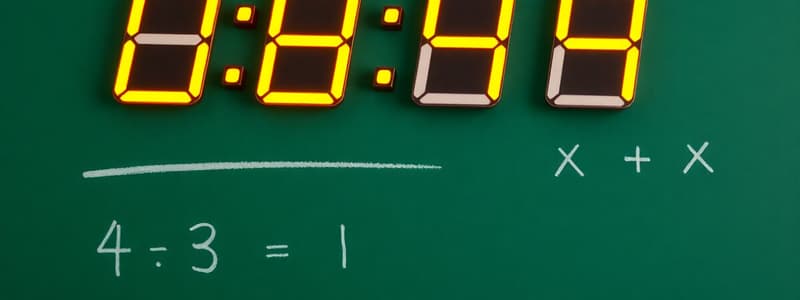Podcast
Questions and Answers
What is the product of 37 and 62?
What is the product of 37 and 62?
- 2114
- 2354
- 2294 (correct)
- 2184
Solve for $x$: $\frac{2}{3}x = 18$.
Solve for $x$: $\frac{2}{3}x = 18$.
- x = 36
- x = 12
- x = 24
- x = 27 (correct)
Calculate $45 \times 28$.
Calculate $45 \times 28$.
- 1160
- 1260 (correct)
- 1400
- 1350
Flashcards
2-Digit Multiplication
2-Digit Multiplication
Multiply each digit of one number by each digit of the other, then add the results. Remember to carry over when necessary.
What is 'x'?
What is 'x'?
A symbol (usually 'x') representing an unknown number that we want to find.
What is a Fraction?
What is a Fraction?
A number expressed as one quantity divided by another, like 1/2 or 3/4.
Solving for x (fraction)
Solving for x (fraction)
Signup and view all the flashcards
Steps: (1/a)x = b
Steps: (1/a)x = b
Signup and view all the flashcards
Study Notes
- 2-digit multiplication involves multiplying a number with two digits by another number, which could be single or double digits.
- Solving for x in equations like (a/b)x = c requires isolating x by multiplying both sides of the equation by the reciprocal of the fraction (b/a).
Steps for 2-Digit Multiplication
- Write the numbers vertically, one above the other, aligning the digits by place value (ones, tens).
- Multiply each digit of the bottom number by each digit of the top number, starting from the ones place.
- Write the partial products, aligning them correctly by place value.
- Add the partial products to get the final product.
- Example: 23 x 12.
- Multiply 2 by 3 to get 6.
- Multiply 2 by 2 to get 4. The first partial product is 46.
- Multiply 1 (tens place) by 3 to get 3, write this under the tens place.
- Multiply 1 by 2 to get 2, write this under the hundreds place. The second partial product is 230.
- Add 46 and 230 to get 276, which is the final product.
Example 2-Digit Multiplication Problems
- 34 x 21:
- Set up the problem vertically.
- 1 x 4 = 4.
- 1 x 3 = 3. First partial product: 34.
- 2 x 4 = 8 (write under the tens place).
- 2 x 3 = 6 (write under the hundreds place). Second partial product: 680.
- Add 34 and 680 to get 714.
- 56 x 15:
- Set up the problem vertically.
- 5 x 6 = 30 (write down 0, carry over 3).
- 5 x 5 = 25 + 3 (carried over) = 28. First partial product: 280.
- 1 x 6 = 6 (write under the tens place).
- 1 x 5 = 5 (write under the hundreds place). Second partial product: 560.
- Add 280 and 560 to get 840.
- 78 x 43:
- Set up the problem vertically.
- 3 x 8 = 24 (write down 4, carry over 2).
- 3 x 7 = 21 + 2 (carried over) = 23. First partial product: 234.
- 4 x 8 = 32 (write down 2 under the tens place, carry over 3).
- 4 x 7 = 28 + 3 (carried over) = 31. Second partial product: 3120.
- Add 234 and 3120 to get 3354.
Solving for x with Fractions
- The goal is to isolate x on one side of the equation.
- If x is multiplied by a fraction (a/b), multiply both sides of the equation by the reciprocal of the fraction (b/a).
- The reciprocal of a fraction switches the numerator and denominator.
- Example: (2/3)x = 8.
- To solve for x, multiply both sides by the reciprocal of 2/3, which is 3/2.
- (3/2) * (2/3)x = 8 * (3/2).
- The left side simplifies to x because (3/2) * (2/3) = 1.
- The right side becomes 8 * (3/2) = 24/2 = 12.
- Therefore, x = 12.
Additional Examples of Solving for x
- (1/4)x = 5:
- Multiply both sides by 4/1 (or simply 4).
- 4 * (1/4)x = 5 * 4.
- x = 20.
- (3/5)x = 9:
- Multiply both sides by 5/3.
- (5/3) * (3/5)x = 9 * (5/3).
- x = 45/3.
- x = 15.
- (5/2)x = 10:
- Multiply both sides by 2/5.
- (2/5) * (5/2)x = 10 * (2/5).
- x = 20/5.
- x = 4.
- (7/3)x = 14:
- Multiply both sides by 3/7.
- (3/7) * (7/3)x = 14 * (3/7).
- x = 42/7.
- x = 6.
- (4/9)x = 8:
- Multiply both sides by 9/4.
- (9/4) * (4/9)x = 8 * (9/4).
- x = 72/4.
- x = 18.
Studying That Suits You
Use AI to generate personalized quizzes and flashcards to suit your learning preferences.
Description
Learn how to perform 2-digit multiplication by hand and solve algebraic equations for x. The multiplication process involves writing numbers vertically and adding partial products. Solving for x requires isolating the variable.




